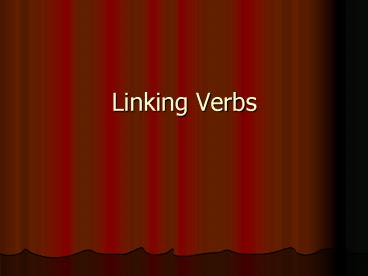Linking Verbs - PowerPoint PPT Presentation
1 / 11
Title:
Linking Verbs
Description:
Linking Verbs Linking Verbs Other verbs express a state of being. These verbs do not refer to action of any sort. They simply tell what the subject is. – PowerPoint PPT presentation
Number of Views:1073
Avg rating:3.0/5.0
Title: Linking Verbs
1
Linking Verbs
2
Linking Verbs
- Other verbs express a state of being.
- These verbs do not refer to action of any sort.
They simply tell what the subject is. - Burt is the gardeners assistant.
- He seems afraid of the swans.
- One swan looks angry.
- In fact, swans are hungry.
3
The most common linking verbs are forms of be
itself.
- Am
- Is
- Are
- Was
- Were
- Be
- Being
- Been
4
Other linking verbs
- Appear
- Become
- Feel
- Grow
- Look
- Seem
- Remain
- Smell
- Sound
- Stay
- Taste
5
Linking Verbs
- A verb that expresses a state of being often
functions as a linking verb. - A linking verb links, or connects, the subject
with a noun or an adjective in the predicate that
names or describes the subject. - Peanut is a toad.
- Peanut is tiny.
6
Some verbs can function as either linking verbs
or action verbs.
Linking Verbs Action Verbs
The lily pond smells stagnant. The squirrel smells its food.
The gardener felt tired. She felt the trees thick leaves.
7
- To help you decide whether one of these verbs is
a linking verb, try substituting is or are for
the verb. If the sentence still makes sense, the
verb is probably a linking verb. - The pigeons look comical. (The pigeons are
comical) - The swans hiss sounds fierce. (The swans hiss
is fierce)
8
Identify each verb in the sentences below. Does
it express action or being?
- We parked and locked our bicycles in the rack at
the library. - Many, many resources were available there.
- I considered several books about wild animals.
- All of the books looked interesting.
- Finally, I decided on one about tropical birds.
- The book described many birds from countries in
Central and South America. - I especially liked the photographs in the book.
- The pictures of the birds are very colorful.
- Some of the birds feathers are pink, orange,
red, and green. - I carried the book home in my backpack.
9
Identify the VERB in each sentence below
- 11. A monkey appears from behind a tree. It
appears excited. - 12. The young deer grew taller. The male deer
grew antlers. - 13. The koala baby looks cute. It looks for its
mother. - 14. The koala tastes a leaf. Does it taste good?
- 15. We smell the eucalyptus tree. It smells
pleasant. - 16. We feel the trees bark. It feels smooth.
10
Identify the VERB in each sentence below
- 17. Photographs, television, and movies show us a
variety of unusual creatures. - 18. We can see animals in their natural habitat
in national parks, nature sanctuaries, or even
city parks. - 19. Few animals look strange to us today.
- 20. Some animals still seem unusual, however.
- 21. The anteater is one example.
- 22. The head and snout of this animal form a long
tube. - 23. A giant anteater becomes six feet long.
- 24. It grows a coarse coat of hair.
- 25. The front toes and claws of the anteater fold
under. - 26. The animal actually walks on its knuckles.
11
Identify the VERB in each sentence below
- 27. The giant anteater usually appears shy.
- 28. It enjoys dark, wet tropical forests.
- 29. Ants and termites appear in this animals
diet. - 30. The anteater is a peaceful animal.































